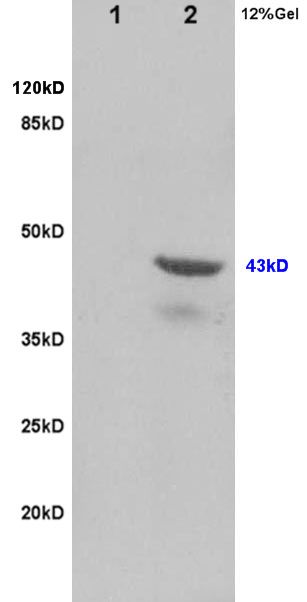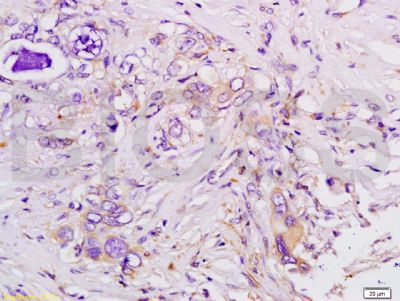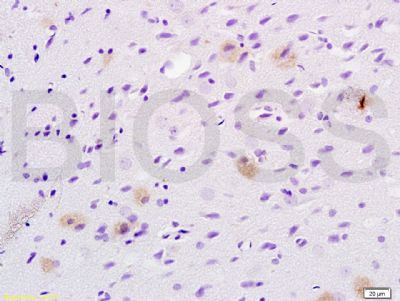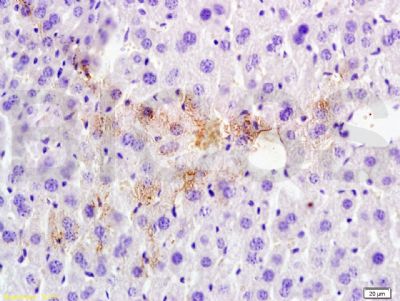产品中心
当前位置:首页>产品中心Anti-Tsg101
货号: bs-1365R 基本售价: 1380.0 元 规格: 100ul
- 规格:100ul
- 价格:1380.00元
- 规格:200ul
- 价格:2200.00元
产品信息
- 产品编号
- bs-1365R
- 英文名称
- Tsg101
- 中文名称
- 肿瘤易感基因101蛋白抗体
- 别 名
- ESCRT I complex subunit TSG101; ESCRT-I complex subunit TSG101; Tsg101; TSG 10; TSG 101; TSG10; Tumor susceptibility gene 10; Tumor susceptibility gene 101; Tumor susceptibility gene 101 protein; Tumor susceptibility protein; Tumor susceptibility protein isoform 3; VPS 23; VPS23; TS101_HUMAN.
- 规格价格
- 100ul/1380元购买 200ul/2200元购买 大包装/询价
- 说 明 书
- 100ul 200ul
- 研究领域
- 肿瘤 细胞生物 免疫学 染色质和核信号 微生物学 细胞分化 表观遗传学
- 抗体来源
- Rabbit
- 克隆类型
- Polyclonal
- 交叉反应
- Human, Mouse, Rat, Dog, Cow, Horse, Rabbit,
- 产品应用
- WB=1:500-2000 ELISA=1:500-1000 IHC-P=1:400-800 IHC-F=1:400-800 IF=1:100-500 (石蜡切片需做抗原修复)
not yet tested in other applications.
optimal dilutions/concentrations should be determined by the end user.
- 分 子 量
- 44kDa
- 细胞定位
- 细胞核 细胞浆 细胞膜
- 性 状
- Lyophilized or Liquid
- 浓 度
- 1mg/ml
- 免 疫 原
- KLH conjugated synthetic peptide derived from human Tsg101:4-120/390
- 亚 型
- IgG
- 纯化方法
- affinity purified by Protein A
- 储 存 液
- 0.01M TBS(pH7.4) with 1% BSA, 0.03% Proclin300 and 50% Glycerol.
- 保存条件
- Store at -20 °C for one year. Avoid repeated freeze/thaw cycles. The lyophilized antibody is stable at room temperature for at least one month and for greater than a year when kept at -20°C. When reconstituted in sterile pH 7.4 0.01M PBS or diluent of antibody the antibody is stable for at least two weeks at 2-4 °C.
- PubMed
- PubMed
- 产品介绍
- background:
The protein encoded by this gene belongs to a group of apparently inactive homologs of ubiquitin-conjugating enzymes. The gene product contains a coiled-coil domain that interacts with stathmin, a cytosolic phosphoprotein implicated in tumorigenesis. The protein may play a role in cell growth and differentiation and act as a negative growth regulator. In vitro steady-state expression of this tumor susceptibility gene appears to be important for maintenance of genomic stability and cell cycle regulation. Mutations and alternative splicing in this gene occur in high frequency in breast cancer and suggest that defects occur during breast cancer tumorigenesis and/or progression. TSG101 also interacts with viral proteins that contain a late-budding motif P-[ST]-A-P. This interaction is essential for viral particle budding of numerous retroviruses like HIV-1 p6, human spumavirus Gag, HTLV-1 Gag, as well as of Ebolavirus VP40.
Function:
Component of the ESCRT-I complex, a regulator of vesicular trafficking process. Binds to ubiquitinated cargo proteins and is required for the sorting of endocytic ubiquitinated cargos into multivesicular bodies (MVBs). Mediates the association between the ESCRT-0 and ESCRT-I complex. Required for completion of cytokinesis; the function requires CEP55. May be involved in cell growth and differentiation. Acts as a negative growth regulator. Involved in the budding of many viruses through an interaction with viral proteins that contain a late-budding motif P-[ST]-A-P. This interaction is essential for viral particle budding of numerous retroviruses.
Subunit:
Component of the ESCRT-I complex (endosomal sorting complex required for transport I) which consists of TSG101, VPS28, a VPS37 protein (VPS37A to -D) and a FAM125/MVB12 protein (FAM125A or -B) in a 1:1:1:1 stoechiometry. Interacts with VPS37A, VPS37B and VPS37C. Interacts with ubiquitin, stathmin, GMCL, DMAP1 and AATF (By similarity). Interacts with HGS; the interaction mediates the association with the ESCRT-0 complex. Interacts with GGA1 and GGA3. Interacts (via UEV domain) with PDCD6IP/AIP1. Interacts with VPS28, SNF8 and VPS36. Self-associates. Interacts with FAM125A/MVB12A; the association appears to be mediated by the TSG101-VPS37 binary subcomplex. Interacts with VPS37D. Interacts with LRSAM1. Interacts with CEP55; the interaction is required for cytokinesis but not for viral budding. Interacts with PDCD6. Interacts with HIV-1 p6. Interacts with human spumavirus Gag. Interacts with HTLV-1 Gag. Interacts with Ebola virus VP40. Interacts with EIAV p9; the interaction has been shown in vitro. Interacts with MGRN1.
Subcellular Location:
Cytoplasm. Membrane; Peripheral membrane protein. Nucleus. Late endosome membrane; Peripheral membrane protein. Note=Mainly cytoplasmic. Membrane-associated when active and soluble when inactive. Depending on the stage of the cell cycle, detected in the nucleus. Colocalized with CEP55 in the midbody during cytokinesis.
Tissue Specificity:
Heart, brain, placenta, lung, liver, skeletal, kidney and pancreas.
Post-translational modifications:
Monoubiquitinated at multiple sites by LRSAM1 and by MGRN1. Ubiquitination inactivates it, possibly by regulating its shuttling between an active membrane-bound protein and an inactive soluble form. Ubiquitination by MGRN1 requires the presence of UBE2D1.
Similarity:
Belongs to the ubiquitin-conjugating enzyme family. UEV subfamily.
Contains 1 SB (steadiness box) domain.
Contains 1 UEV (ubiquitin E2 variant) domain.
SWISS:
Q99816
Gene ID:
7251
Database links:Entrez Gene: 7251 Human
Entrez Gene: 22088 Mouse
Entrez Gene: 292925 Rat
Omim: 601387 Human
SwissProt: Q99816 Human
SwissProt: Q61187 Mouse
SwissProt: Q6IRE4 Rat
Unigene: 523512 Human
Unigene: 241334 Mouse
Unigene: 7410 Rat
Important Note:
This product as supplied is intended for research use only, not for use in human, therapeutic or diagnostic applications.
- 产品图片
 Sample:
Sample:
Lane1: Brain (Rat) Lysate at 30 ug
Lane2: Heart(Rat) Lysate at 30 ug
Primary: Anti-Tsg101 (bs-1365R) at 1:200 dilution;
Secondary: HRP conjugated Goat-Anti-Rabbit IgG(bse-0295G) at 1: 3000 dilution;
Predicted band size : 43kD
Observed band size : 43kD Tissue/cell: human colon carcinoma; 4% Paraformaldehyde-fixed and paraffin-embedded;
Tissue/cell: human colon carcinoma; 4% Paraformaldehyde-fixed and paraffin-embedded;
Antigen retrieval: citrate buffer ( 0.01M, pH 6.0 ), Boiling bathing for 15min; Block endogenous peroxidase by 3% Hydrogen peroxide for 30min; Blocking buffer (normal goat serum,C-0005) at 37℃ for 20 min;
Incubation: Anti-Tsg101 Polyclonal Antibody, Unconjugated(bs-1365R) 1:200, overnight at 4°C, followed by conjugation to the secondary antibody(SP-0023) and DAB(C-0010) staining Tissue/cell: rat brain tissue; 4% Paraformaldehyde-fixed and paraffin-embedded;
Tissue/cell: rat brain tissue; 4% Paraformaldehyde-fixed and paraffin-embedded;
Antigen retrieval: citrate buffer ( 0.01M, pH 6.0 ), Boiling bathing for 15min; Block endogenous peroxidase by 3% Hydrogen peroxide for 30min; Blocking buffer (normal goat serum,C-0005) at 37℃ for 20 min;
Incubation: Anti-Tsg101 Polyclonal Antibody, Unconjugated(bs-1365R) 1:200, overnight at 4°C, followed by conjugation to the secondary antibody(SP-0023) and DAB(C-0010) staining Tissue/cell: rat liver tissue; 4% Paraformaldehyde-fixed and paraffin-embedded;
Tissue/cell: rat liver tissue; 4% Paraformaldehyde-fixed and paraffin-embedded;
Antigen retrieval: citrate buffer ( 0.01M, pH 6.0 ), Boiling bathing for 15min; Block endogenous peroxidase by 3% Hydrogen peroxide for 30min; Blocking buffer (normal goat serum,C-0005) at 37℃ for 20 min;
Incubation: Anti-Tsg101 Polyclonal Antibody, Unconjugated(bs-1365R) 1:200, overnight at 4°C, followed by conjugation to the secondary antibody(SP-0023) and DAB(C-0010) staining

